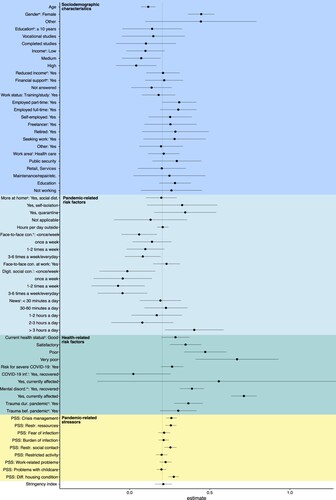Figures & data
Table 1. Sociodemographic characteristics (N = 4607).
Table 2. Pandemic-related characteristics (N = 4607).
Table 3. Health-related characteristics (N = 4607)
Table 4. Pandemic-related stressors (N = 4607).
Figure 1. Effect estimates of regression analysis.
Notes. Effect estimates are unstandardised regression coefficients. Reference categories: a Male. b Less than 10 years of schooling. c Very low. d No. e No. f Other. g No. h No personal contact with other people. i No contact by phone, skype, etc. j I do not watch, read or listen to news about the coronavirus pandemic. k Very good. l No. m No. n No. o No. ≥ 10 years = 10 or more years of schooling. Reduced income = Reduced monthly household income due to the coronavirus. Financial support = Receiving financial support from the government. Maintenance/repair/etc.= Maintenance, repair, construction. More at home = Spent more time at home due to the coronavirus pandemic. social dist. = Spent more time at home as a precautionary measure (social distancing). Self-isolation = Stayed at home in self-isolation because of self-infection. quarantine = Stayed at home due to contact with infected people or being in risk areas. Face contact = Face-to-face contact to loved ones or friends. Face contact at work = Work involve (almost) daily face-to-face contact with other people. Digital contact = Digital contact with loved ones or friends, e.g. by phone, Skype or Zoom. News = Hours a day watching, reading or listening to news or other information about the coronavirus pandemic. COVID-19 inf. = Infected (i.e. tested positive) with the coronavirus.

Table 5. Effect estimates of regression analysis (N = 4607).
Data availability
The detailed sociodemographic and clinical information of the dataset does not fully protect the anonymity of the respondents. For this reason, the entire dataset cannot be made publicly available. However, excerpts of the data on a higher aggregation level can be provided upon justified request by the first author.
